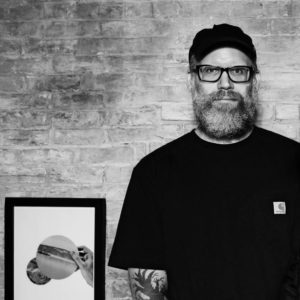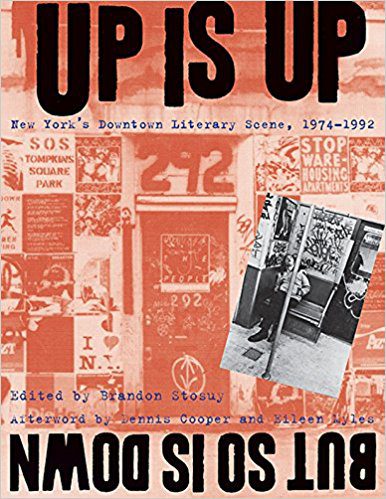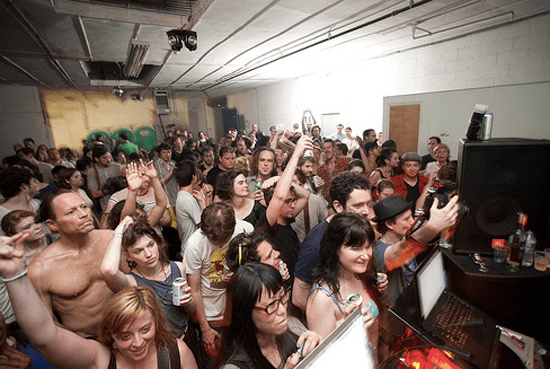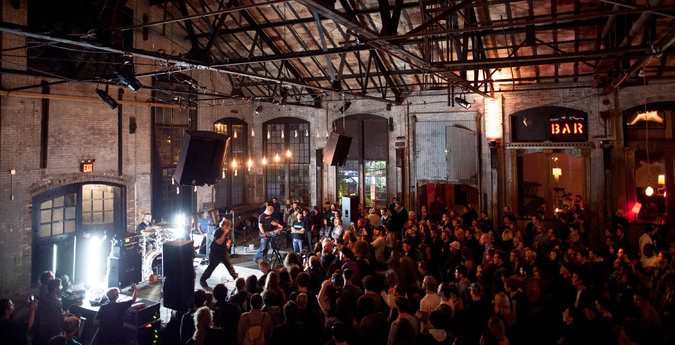
Welcome back to Sound & Vision, the Rumpus profile series that spotlights the creative talents of those whose work connects to music. This month I’m very excited to talk with Brandon Stosuy. Formerly the Director of Editorial Operations at Pitchfork, Stosuy is currently the Editor-in-Chief of The Creative Independent, a growing resource of emotional and practical guidance for creative people. A longtime music curator at MoMA PS1 in New York City, Stosuy now curates for the Broad Museum in Los Angeles, and he co-curates the Basilica Soundscape. An annual festival in Hudson, New York, this immersive event features a thoughtful lineup of innovative and genre-pushing musicians, visual artists and writers. This year it will be held from September 15–17.
***
The Rumpus: There is a strong sense of curation across all of the work you do. How did you first develop your aesthetic sense?
Brandon Stosuy: My hometown in New Jersey has a population of about eight hundred, and I lived near a blueberry farm off a dirt road. But my father had grown up in East New York, and my mom grew up in Queens, so we had relatives in New York. When we visited them, I was able to wander around. Where we lived also wasn’t far from Philadelphia, so once I had the ability to drive, going there also put me in touch with the outside world. But even when I was younger, corresponding with other people who were into music and zines gave me access to a culture and a broader network. I spent an amazing amount of time as a teenager hand-writing these really long letters to people I barely knew. It’s funny. Just this weekend I was cleaning out my basement with my wife, and I came across some 7” records, cassette tapes, and zines I made when I was younger. Thankfully I saved all of this stuff.
Rumpus: What were the kids in your town into?
Stosuy: There weren’t too many kids in my town, which had a lot of older farmers. My town didn’t even have its own school. It sounds like a cliché when people tell their kids how hard they once had it, but I actually did walk a mile to the bus. I also had to pretend to go to this one house that wasn’t mine because legally the bus driver wasn’t supposed to drop me off that far away from where I lived, which was out of the busing zone. Now underground music is considered kind of cool, but at the time it was seen as very, very lame. Almost everyone was listening to Vanilla Ice, New Kids on the Block, pop radio, and classic rock. My friend Moss, who I’ve known since first grade, and I discovered a lot of stuff together—7 Seconds, Minor Threat, and all that stuff.
Rumpus: Was going to college the first time you were away from home for any sustained period of time?
Stosuy: Yes, I went to Rutgers in New Brunswick and it was very exciting for me because there was a lot happening there. One of my roommates was really into Jesus Lizard and noisy New York music like no wave and all that. I lived in a house with eight people and we’d have shows in our basement, I had a zine, and I worked in an independent record store called Cheap Thrills. I was also the music editor at the school newspaper—I started out there as a writer and being involved in music put me in more contact with a lot of people I never knew before.
Rumpus: What kind of student were you?
Stosuy: I was doing well in class, but every moment outside of class was music: working at the radio station, running record labels, putting on shows.
Rumpus: Were you thinking that music would be your career path?
Stosuy: You know, I’d interned at Musician Magazine and Nathan Brackett, who supervised me, went on to Rolling Stone, so there were possibilities. But as a senior I decided to move to Portland, Oregon because I didn’t want a job right away. I wanted to learn how to write fiction, and spend time reading. I took only what would fit in my van, and I made a desk out of milk crates. As it turned out, I knew more people in Portland than I thought, and my friend Eric who worked at Odwalla would bring me juice every night. I was vegan so I lived on that and pretzels. I was working at Borders, but no one was going there because they were all at Powell’s—the big independent bookstore. I was just hanging out in the politics section organizing giant Noam Chomsky displays.
Rumpus: Were you still involved in music or writing?
Stosuy: My family was working class, so I never thought I could live off of writing. I always assumed I’d jump from job to job, writing at night. While I was in Portland I met a Canadian woman and snuck into Canada. When I applied for a gas station job there, one of my references was Nathan, and people were really impressed that I knew some guy from Rolling Stone. I started thinking maybe I should have taken advantage of some of the connections I had made in college. I pawned off some of my things and started hanging out in the library, just reading people like Derrida and Foucault. One thing kind of led to another, and I decided I needed to get back to school.
Rumpus: How did you get back into academia?
Stosuy: When I was at Borders I I met this woman, Kate, who was older and knew everything about books. After I left we kept in touch and she was the one who recommended the University of Buffalo when I mentioned all the stuff I was reading in Canada. There were all of theorists there and I was also really into Samuel Delaney who was there, too. I ended up going but leaving after I got my masters because I wanted to get back out there and write.
Rumpus: Yes, being an academic isn’t necessarily the same as being a pubic intellectual.
Stosuy: Right. I’d been working with Dennis Cooper at school and he hooked me up with the NYU Library, working on the Downtown collection. While I was there I ended up writing the book Up Is Up, But So Is Down, an anthology of downtown New York literary stuff. Over time, I was able to leave behind my other jobs and do the writing thing full time. At the time I was in my mid-to-late twenties.
Rumpus: Was that when you started at Pitchfork?
Stosuy: I was writing for them back then, but at the time they didn’t have enough money to pay anyone to write for them full time, so I ended up at Stereogum. That was my first actual “job” where I was paid to write all day. There were benefits and everything.
Rumpus: You went on to write several books, including ADAC, a collaboration with the artist Matthew Barney to commemorate the lives of NFL/Oakland Raiders legend Al Davis and Seth Putnam, vocalist of the grindcore band Anal Cunt. You also wrote a children’s book, Music Is…, which was published last year. But you’re never “just” writing, you’re also very actively involved in programming—which is somewhat rare.
Stosuy: I’ve always been interested in figuring out how to put a show on. We had nothing going on back home, so we had to make it happen ourselves. I took that with me, to Pitchfork and other places. For example, I did a couple of DJ events with Bjork [pictured below] that connected me to MoMA PS 1. That led to working with this guy Ed Patuto at ISSUE Project Room, and when he moved to LA I started doing stuff with him at the Broad Museum. Someone recently asked me if I missed reviewing albums. Honestly I don’t. At this point, I’m more excited to do shows.
Rumpus: Well, music journalism has also changed a lot over the period of your career. There are more independent publication venues, but the album release cycle has become very compressed. It’s all about instant grats, being the first out with the exclusive, or pre-release interview or review. In a way I think it’s made it less fun for everyone.
Stosuy: Yes. Artists spend a lot of time and thought making albums but people move through their work so quickly. I remember when that new My Bloody Valentine album MBV came out a couple of years ago and everyone was listening to it online at the same time. But then everyone sort of forgot about it immediately. That was so different from when Loveless came out. I remember buying that one at the record store and going home listening to it nonstop for a month. The industry has changed but in general there’s also just less downtime now, and more distractions. I didn’t have a cell phone for the longest time, but then I’d have a meeting and the time would be changed last minute but I wouldn’t know about it because I couldn’t be reached. I realized I needed to get one, but it changed the way I dealt with time.
Rumpus: This might be a good segue to talking about The Creative Independent. How did that project come about?
Stosuy: Kickstarter’s headquarters was a block away from Pitchfork’s, and Yancey [Strickler], who’s one of the people who started Kickstarter and I were in a coffee shop one day and just started talking. At the time there was a part of me that felt I’d done all I could at Pitchfork and once it became part of Condé Nast I didn’t feel as connected to it. Yancey said he wanted to have some kind of editorial site that was connected to Kickstarter but also separate from it, something focused on creativity. He asked if I knew of anyone who would want to run something like that. I said I’d give it some thought, and then I realized I would want to do that myself.
Rumpus: Tell me more about your goals for the site.
Stosuy: The idea behind The Creative Independent is to be a resource, so the entries on the site aren’t tied to the promotion of album releases. They’re more about process, and they may inspire others, so if someone is out there reading, maybe they’ll say, “Oh, now I’m going to write that story I’ve always wanted to write. “ Or if they’re having a creative block, they might read about how someone else worked through it. People aren’t always asked these kinds of questions, so you can get really illuminating responses.
Rumpus: So it’s one interview every day?
Stosuy: It doesn’t have to be an interview every day necessarily. We’ve started shifting things around a bit lately. For example, we recently ran a piece by Hope Hall, who’s an independent filmmaker, about how to slow things down. I’d like to have more things like that, insightful pieces, for example asking a single question or maybe two questions, with the goal being to respond deeply. There is also practical stuff, too, like asking people when they decided to hire their first manager or publicist. As creative people move from one level to another in their work, we want to be a resource for how to negotiate those transitions. It’s empowering to know you can figure out this stuff with some help from others who’ve done it. The goal is to make this a resource, both emotional and practical.
Rumpus: There are also workshops that have grown out of the site?
Stosuy: Yes, readings and shows are great but we’ve also tried to do more proper workshops. For example, one of our writers, Amy Rose Spiegel, led a discussion at National Sawdust with Victoria Ruiz from Downtown Boys and the Tunisian singer/songwriter Emel Mathlouthi about how they go about using music to protest. We recorded it so it could be shared more widely. And, Charlotte Zoller, who also works here had an idea about organizing a panel on selling merchandise online, how to brand, and so forth.
Rumpus: The business side of creativity has often been overlooked in other publications.
Stosuy: Not always. One of my conceptual inspirations for The Creative Independent is Maximum Rocknroll’s Book Your Own Fuckin’ Life, where it’s all about being DIY. In college, me and my friend Moss had a band and we booked a month-long tour just using that resource. But years before that I put on my first hardcore show in my backyard when I was only thirteen. I figured out that if I could make a flyer, and borrow a PA, I could put something together and people would come. By the time I was seventeen I put on a two-day festival on my dad’s farm, and close to a thousand people showed up. You learn how to do a lot of stuff by just doing it, and you can share that practical information with others.
Rumpus: Today you can still start your own zine, or cassette label, or gig at an independent radio station, but it’s not usually a big career move from the financial point of view. Do you think artists have to be savvier about how to monetize their work?
Stosuy: Things are different now. For example when I was coming of age no one was interested in sponsorship. Converse, Vans, and other brands weren’t knocking on doors and bands would have probably turned them away for fear of looking like sellouts. But things have shifted. It was easier before to be a purist. But now we can’t pretend to do it only because we “love it” anymore.
Rumpus: At the same time, people have a better understanding that musicians shouldn’t be working for free.
Stosuy: Absolutely. We all had day jobs but there were definitely people we knew who weren’t working, and you kind of knew something was going on, that they were financed by their parents or something. But even today, a lot of people expect young people to work for free, for the “exposure.”
Rumpus: It’s complicated, especially if an apprenticeship only leads to an endless chain of other apprenticeships. But to come back to this idea of slowing things down, and rethinking the utility of the dominant industry model, perhaps we should talk about your work as a curator for the Basilica Soundscape. Unlike a typical music festival, the scale is intentionally smaller and a lot more eclectic.
Stosuy: Instead of three stages at once, it’s one thing at a time, mixing up art, music, readings, and conversations. We want it to be more like an intimate show rather than you standing in a field with 30,000 other people watching a massive stage from a distance. It all happens within a 19th century factory owned by my friends Melissa [Auf der Maur] and Tony [Stone].
Rumpus: The audience is tiny compared to something like Coachella, right? Has there been pressure to grow?
Stosuy: People have suggested we add a stage outside, but we’ve resisted that. We do it without sponsors and run the space on solar power to keep our footprint in check. We’ve been there for six years and nothing crazy has happened. We don’t expect to get rich from it, but we hope always to break even, keep it sustainable. Our idea is to put something together that makes sense conceptually, not necessarily what’s the biggest headline of the day, the lineup you could see at any festival. It’s all about making connections, creating unique experiences.
Rumpus: How long have you been doing this?
Stosuy: When I first started doing it my son Henry was a one-year-old and he just turned seven. We’ve had the same photographer take our family photograph every year, and the same DJ for the after-party—Cole who works for The Creative Independent and his boyfriend have an event called “Rainbow in the Dark” which is dance music they program along with Robin from Triangle Records and Drew from Matos. And another night it’s local DJs from Hudson. It really feels like a community.
Rumpus: In general, it sounds like you’re trying to slow things down and eliminate distractions so that people can really savor experiences. But there is one area of your work where you have, in fact, tried to speed up time. That’s the Trump clock. Tell me more about that project.
Stosuy: [Laughs] I do a series of events in Long Island City with Matthew Barney called REMAINS. It’s been going on for about ten years now, and we always try to do events that can’t happen anywhere else. This year we had Josh Fadem do a physical comedy set co-curated with Vernon Chatman who’s a writer for South Park and Louis CK, etc. The Trump Clock idea was part of this. It started with Matthew, who had taken his teenage daughter to the Women’s March and they were both so energized. His studio is right across from the UN and he looked at it one day and thought, “Whoa! I could do something here that Trump might actually see!” He came up with the idea for a clock that would count down the days and hours remaining in the Trump presidency. My wife Jane is an architect, so I suggested they could work together with a lighting designer to actually build this thing. Our hope is that something will happen and we can turn it off before the end of Trump’s term.
***
BONUS MATERIAL
This year’s Basilica Soundscape will take place in Hudson, New York from September 15–17. The lineup includes Zola Jesus, Protomartyr, Priests, Eileen Myles, Patty Schemel, Naama Tsabar, and more! For tickets and information, click here.
Since its inception in 2016, The Creative Independent has featured hundreds of artists—including musicians, authors, filmmakers, dancers, and designers. If you’re new to the site, Brandon has suggested this nice mix to get you started:
Anohni on art corporations and the music industry
Ocean Vuong on being generous in your work
Interview with writer and poet Maggie Nelson
Hilton Als on writing
Henry Rollins on defining success
Layli Long Soldier on poetry as prayer
Tschabalala Self on not being afraid of hard work
Philip Glass on controlling your output and getting paid
Alexandra Drewchin on being patient with your projects
Kameelah Janan Rasheed on researching and archiving
***
Feature photograph © Samantha Marble. Photo of Basilica Soundscape © Brian Harkin for the New York Times. All images provided courtesy of Brandon Stosuy.
***
This interview has been edited and condensed. If you’d like to recommend someone for “Sound & Vision,” drop Allyson a line here









